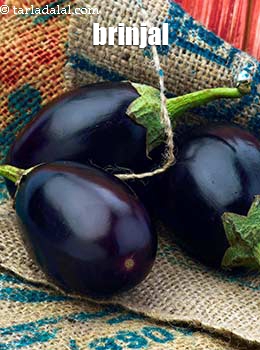
Also Known As
Eggplant, Aubergine, Baingan, Vaangi, ringan, Vankaya, bintak, Bhanta
What is brinjal, baingan?
Brinjal belongs to the family of Solanaceae, also commonly known as nightshades, and are cousins of potatoes, tomatoes and bell peppers. They hang from vines and some varieties actually look egg shaped- which is why the name "Eggplants".
The skin is glossy and usually deep purple in color, while the flesh is creamish and spongy in texture. A much wider range of shapes, sizes and colors is grown in Asia. Colours vary from white, yellow to green as well as reddish-purple, dark purple, black etc. There is also a variety which is green brinjals with white striping.
While the different varieties vary slightly in taste and texture, it usually has a mild bitter taste. To reduce the bitterness (if required- it is actually not required most of the times), slice the brinjal, sprinkle salt evenly over it and mix well. Rinse well after 10 minutes and use as required.
Brinjal cubes
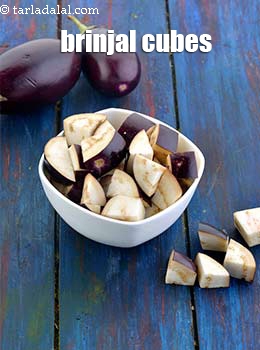
To cube medium sized brinjals, wash, pat dry and place on a chopping board. Cut off the stem and make a cut from the centre to cut into halves. Now, place each halve on the chopping board, with the purple skin facing you and make 3 vertical slits lengthwise on each halve. Cut each vertical slit again into 3 to 4 equal pieces breadthwise to get cubes. Make finer or thicker slits to cut cubes according to the size of the brinjal and your recipe requirement. Brinjal cubes are commonly used in gravies, stews and dry subzis.
Brinjal slices
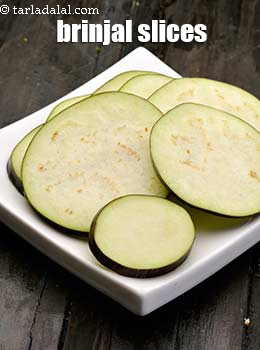
To slice brinjals, wash, pat dry and place on a chopping board. Cut off the stem and and cut into equal sized round slices as per the recipe requirement, starting with horizontal cuts from one end of the brinjal to the other.
Sliced brinjals are good for grilling and baking and used in popular recipes like Lasagne and Eggplant Parmigianna.
Chopped brinjals
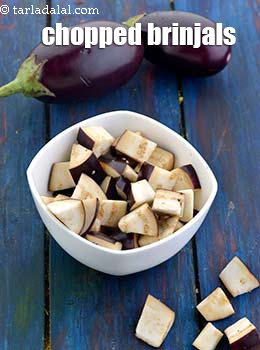
To chop medium sized brinjals, wash, pat dry and place on a chopping board. Cut off the stem and make a cut from the centre to cut into halves. Now, place each halve on the chopping board, with the purple skin facing you and make 6 to 7 vertical slits lengthwise on each halve. Combine all the vertical slits together and cut at equal intervals to get chopped brinjal. Make finer or thicker slits to chop according to the size of the brinjal and your recipe requirement. Chopped brinjal is commonly used in stir fries or to make fillings for savoury quiche, tarts etc.
Fried brinjals
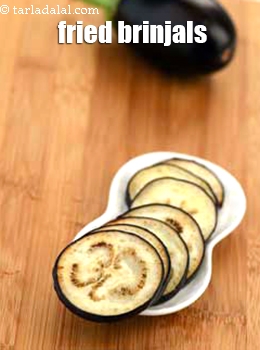
To fry medium sized brinjals, wash, pat dry and place on a chopping board. Cut off the stem. You may cut the brinjal into roundels, into quarters or cubes and then fry as per recipe requirements. If deep frying brinjal roundels directly without any batter etc, then ensure that the oil is hot enough before you fry the brinjals. Once the oil is hot, reduce the flame and add the roundels, few at a time, to the hot oil. Deep fry till crisp and semi golden brown in colour. Drain off excess oil and transfer on to absorbent paper. Use as required. Deep fried brinjals are used as starters or in pickles.
Roasted brinjal

To roast brinjals, wash, pat dry and place on a chopping board. Do not cut off the stem. Smear the brinjal with some oil and place on gas stove on direct flame. Keep turning the sides when you see the skin of the brinjal getting black and trying to peel off from one end.. When roasted from all sides, it will be charred and the skin will be cracked and wil be easy to peel off. The inner flesh will be visible and soft and may ooze out some juices. Allow to cool completely. You may immerse in water and then peel the skin off which will aid in quick peeling. Roasted brinjal is usually pulped in a blender and then used to make dips, spreads, chutneys and some gravies.
Sliced brinjals
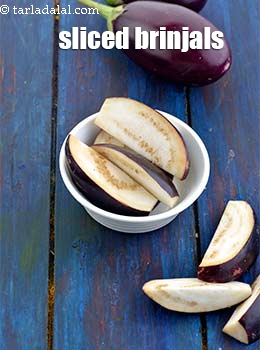
To slice medium sized brinjals, wash, pat dry and place on a chopping board. Cut off the stem and make a cut from the centre to cut into halves. Now, place each halve on the chopping board, with the purple skin facing you and make vertical slits at equal intervals on each halve to get slices. The same slits can alternatively be made horizontally too. Make finer or thicker slices according to the size of the brinjal and your recipe requirement. Brinjal slices are commonly used in baked recipes where you have to layer the vegetables. They can also be used instead of roundels to make fritters.
How to select brinjal, baingan
There are various varieties, colours and sizes (from the size of a tomato to the size of a bottle gourd) to choose from. Whichever variety you choose, ensure that the vegetable is firm to handle, free from blemishes, cuts or any tiny holes. The stem should be bright green in colour.
Culinary uses of brinjal, baingan
With a super-rich
besan and jaggery based stuffing,
Bharwan Baingan is the perfect example showcasing the use of spices in
Punjabi Cuisine.
Being as versatile as a tomato, the combination of Brinjal with different vegetables works great.
Aloo Baingan is a staple in India, but jazzing it up with
saunf gives a peculiar taste that is hard to resist. Combination with curds,
kalonji and many other spices gives a birth to a slightly
khatta subzi called
Achaari Baingan.
Roasted brinjals give a very earthy, yummy taste to a dish and when cooked with tangy tomatoes and onions, make a delectable subzi of Baingan Bharta. A similar subzi, which gets its origin from the Mughals, called Baingan Musasalam, is a mouth-watering concoction of flavours.
Baingan Potato and Green Peas Sabzi is a classic that cannot go wrong, with different vegetables mixed to get different flavours and textures.
· Brinjal can be used in recipes that require braising, stir frying, baking, deep frying, roasting etc. Thus, it proves to be a very versatile ingredient.
· It is used commonly in a pureed form to make dips, chutneys etc. In order to roast brinjals, smear the brinjal with some oil and then place on open fire and roast. When the skin starts to peel off and the flesh feels soft and juicy, it is well roasted. Cool and peel off the outer skin. Blend in a mixer or pulp using your hands to get smooth brinjal pulp. This pulp can be combined with curds and a basic tempering of mustard seeds and curry leaves to make brinjal raitha. Alternatively, combine with red chillies and urad dal make spicy chutneys.
· Brinjal pulp is also used to make the delicious and well known Punjabi delicacy "Baingan ka bharta" which is brinjal pulp cooked with garlic, onions, tomatoes, lemon juice and spices. It is served with hot tandoori rotis.
· Deep fried brinjals can be pickled and used as an accompaniment with rice.
· Brinjal pulp is blended with tahini (sesame seed paste), garlic and lemon juice to make a famous Middle eastern dip called Baba Ghanoush. Serve this dip with crackers, bread sticks etc. This dip can also be used as a spread for sandwiches, as a topping on canapés etc.
· Chinese use it for recipes like stewed eggplants, braised egg plants etc which goes as an accompanying dish to noodles, stir fried rice etc.
· In the famous French steed recipe Raatouille, brinjals plays an important role. It is cooked along with garlic, tomatoes and herbs ans is an aromatic accompaniment in French menus.
· Brinjals are cut into halves and baked till semi cooked. The inner flesh is removed and mixed with herbs and cheese and stuffed in the scooped brinjals. This is then topped with cheese and gratinated till the cheese melts. This Italian dish is called Melanzane alla parmigiana.
· Brinjals are cubed and used commonly in Southern parts of India as a vegetable to be used in sambhar, Kootu (dal based gravies), Avial etc.
· In Maharashtra, Brinjals are stir fried and cooked with rice to make spicy bhaat. Baby brinjals are slit into four keeping the stem intact and stuffed with a spicy coconut, sesame and peanut stuffing. This is called Masale chi Vaangi.
· Slice large brinjals thinly, dip in a spiced gram flour batter and deep fry to make fritters or pakodas. Sprinkle chaat masala on top and serve with tomato sauce etc.
· Use baked brinjals in salads. Combine cubed and baked brinjals with grilled vegetables like bell peppers, baby corn, zucchini and top with crushed garlic and a balsamic vinaigrette.
How to store brinjal, baingan
Do not cut brinjals before you store it as it perishes quickly once its skin has been punctured or its inner flesh is exposed. Place uncut brinjals in a zip lock bag or plastic bag and store in the refrigerator.
Health Benefits of brinjal, baingan
· 1. Good for Diabetics
Brinjal has a Glycemic Index of 15 which is low. Glycemic Index are for foods you eat, ranks carbohydrate-containing foods by how quickly they digest and raise your blood sugar or glucose levels. Foods rank from 0 to 50 are low GI, 51 to 69 are medium and 70 to 100 are high. Foods that are high in GI are not suitable for weight loss and diabetics. Foods like Brinjal have a low GI and hence don't spike your glucose level as they are absorbed slowly. Low carb recipe like Baingan Bhaja can be enjoyed by diabetics.
2. Great for weight loss
Brinjal is low in calories. A cup of chopped brinjal contains only 30 calories and can help you in managing your weight. It contains negligible amount of fats and provides bulk to your diet and thus promotes satiety helping you to eat lesser in between meals. Therefore, it promotes weight loss. Hyderabadi Baingan Subzi is a great low calorie dish to have for Lunch or dinner if you’re trying to lose weight.
3. High in Fibre
Brinjals are a very good source of fibre. Add a variety of fruits and vegetables in your diet for regular bowel movements. Fibre acts as a laxative and will prevent or treat constipation. Fibre also reduces the fat absorption and helps to maintain weight. It also prevents blood glucose from shooting up and is good for diabetics.
It is a good source of dietary fiber and minerals like manganese, copper and potassium.
· It is also a good source of Vitamin B1 (thiamin), Vitamin B6, folate, magnesium and niacin.
· Brinjal contains phytonutrients which include phenolic compounds. These compounds act as antioxidants. Two such phytonutrients are chlorogenic acid and nasunin which are potent antioxidants and thus prevents formation of free radicals, thereby protecting cell membranes from damage.
Glycemic Index
Brinjal has a Glycemic Index of 15 which is low. Glycemic Index are for foods you eat, ranks carbohydrate-containing foods by how quickly they digest and raise your blood sugar or glucose levels. Foods rank from 0 to 50 are low GI, 51 to 69 are medium and 70 to 100 are high. Foods that are high in GI are not suitable for weight loss and diabetics. Foods like Brinjal have a low GI and hence don't spike your glucose level as they are absorbed slowly. Great for weight loss.